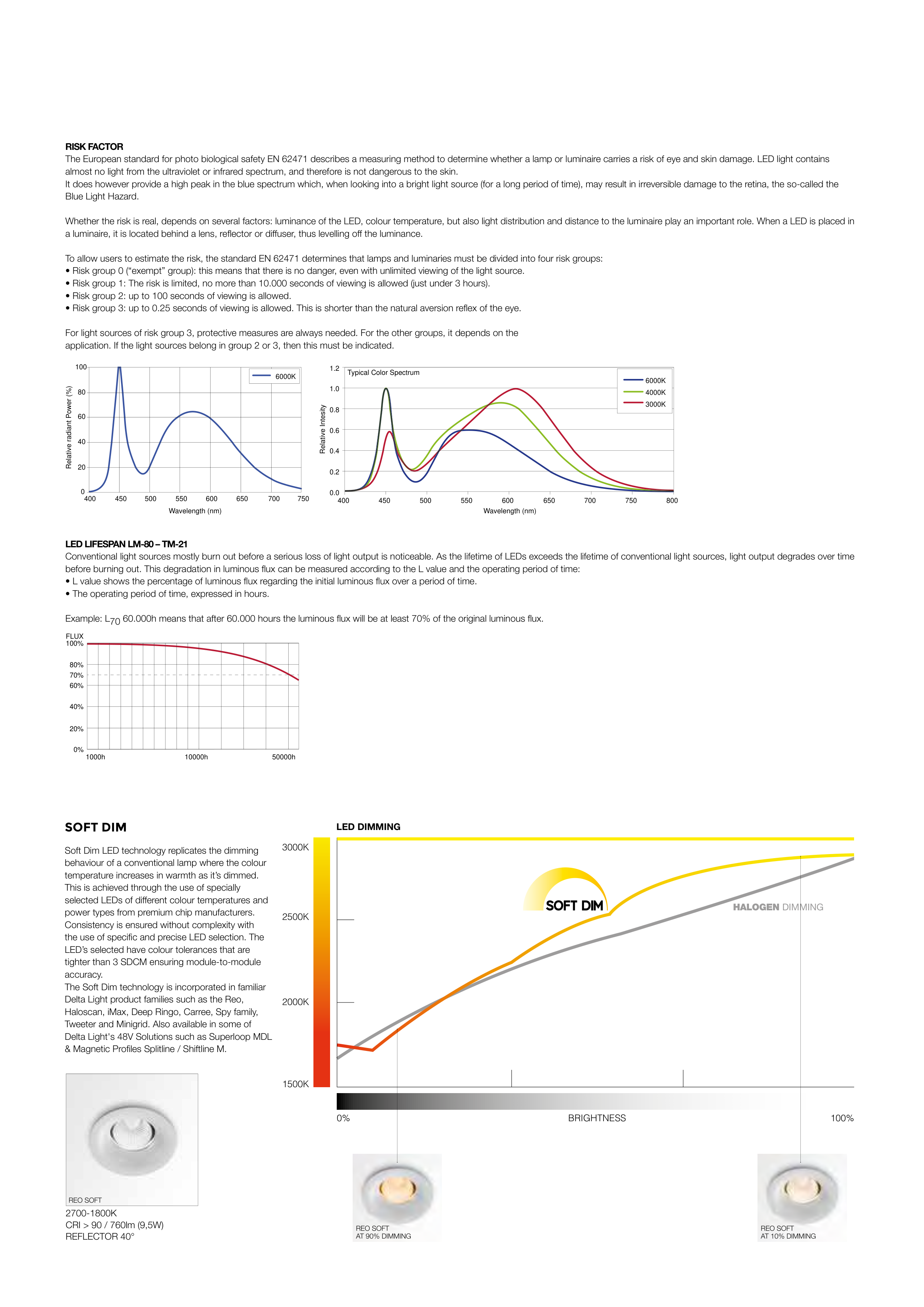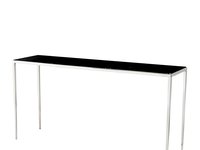2700-1800K
CRI > 90 / 760lm (9,5W)
REFLECTOR 40°
LED DIMMING
3000K
2500K
2000K
HALOGEN DIMMING
DIMMING
1500K
0%
BRIGHTNESS
100%
REO SOFT
REO SOFT
AT 10% DIMMING
REO SOFT
AT 90% DIMMING
SOFT DIM
Soft Dim LED technology replicates the dimming
behaviour of a conventional lamp where the colour
temperature increases in warmth as it’s dimmed.
This is achieved through the use of specially
selected LEDs of different colour temperatures and
power types from premium chip manufacturers.
Consistency is ensured without complexity with
the use of specific and precise LED selection. The
LED’s selected have colour tolerances that are
tighter than 3 SDCM ensuring module-to-module
accuracy.
The Soft Dim technology is incorporated in familiar
Delta Light product families such as the Reo,
Haloscan, iMax, Deep Ringo, Carree, Spy family,
Tweeter and Minigrid. Also available in some of
Delta Light's 48V Solutions such as Superloop MDL
& Magnetic Profiles Splitline / Shiftline M.
RISK FACTOR
The European standard for photo biological safety EN 62471 describes a measuring method to determine whether a lamp or luminaire carries a risk of eye and skin damage. LED light contains
almost no light from the ultraviolet or infrared spectrum, and therefore is not dangerous to the skin.
It does however provide a high peak in the blue spectrum which, when looking into a bright light source (for a long period of time), may result in irreversible damage to the retina, the so-called the
Blue Light Hazard.
Whether the risk is real, depends on several factors: luminance of the LED, colour temperature, but also light distribution and distance to the luminaire play an important role. When a LED is placed in
a luminaire, it is located behind a lens, reflector or diffuser, thus levelling off the luminance.
To allow users to estimate the risk, the standard EN 62471 determines that lamps and luminaries must be divided into four risk groups:
• Risk group 0 (“exempt” group): this means that there is no danger, even with unlimited viewing of the light source.
• Risk group 1: The risk is limited, no more than 10.000 seconds of viewing is allowed (just under 3 hours).
• Risk group 2: up to 100 seconds of viewing is allowed.
• Risk group 3: up to 0.25 seconds of viewing is allowed. This is shorter than the natural aversion reflex of the eye.
For light sources of risk group 3, protective measures are always needed. For the other groups, it depends on the
application. If the light sources belong in group 2 or 3, then this must be indicated.
LED LIFESPAN LM-80 – TM-21
Conventional light sources mostly burn out before a serious loss of light output is noticeable. As the lifetime of LEDs exceeds the lifetime of conventional light sources, light output degrades over time
before burning out. This degradation in luminous flux can be measured according to the L value and the operating period of time:
• L value shows the percentage of luminous flux regarding the initial luminous flux over a period of time.
• The operating period of time, expressed in hours.
Example: L70 60.000h means that after 60.000 hours the luminous flux will be at least 70% of the original luminous flux.
6000K
MacAdam STEP 4 ELIPSE
MacAdam STEP 3 ELIPSE
MacAdam STEP 2 ELIPSE
MacAdam STEP 1 ELIPSE
NOTE
A & B ARE EACH 1 SDCM FROM THE TARGET
BUT 2 SDCM FROM EACH OTHER
C & D ARE EACH 2 SDCM FROM THE TARGET
BUT 4 SDCM FROM EACH OTHER
400
0
20
40
60
80
100
450
650
750
500
550
600
700
Relative radiant Power (%)
Wavelength (nm)
Wavelength (nm)
400
A
B
D
C
0.0
0.2
0.4
0.6
0.8
1.0
1.2
450
650
750
500
550
600
700
800
Relative Intesity
Typical Color Spectrum
6000K
3000K
4000K
0%
1000h
10000h
50000h
20%
40%
60%
70%
80%
100%
FLUX







